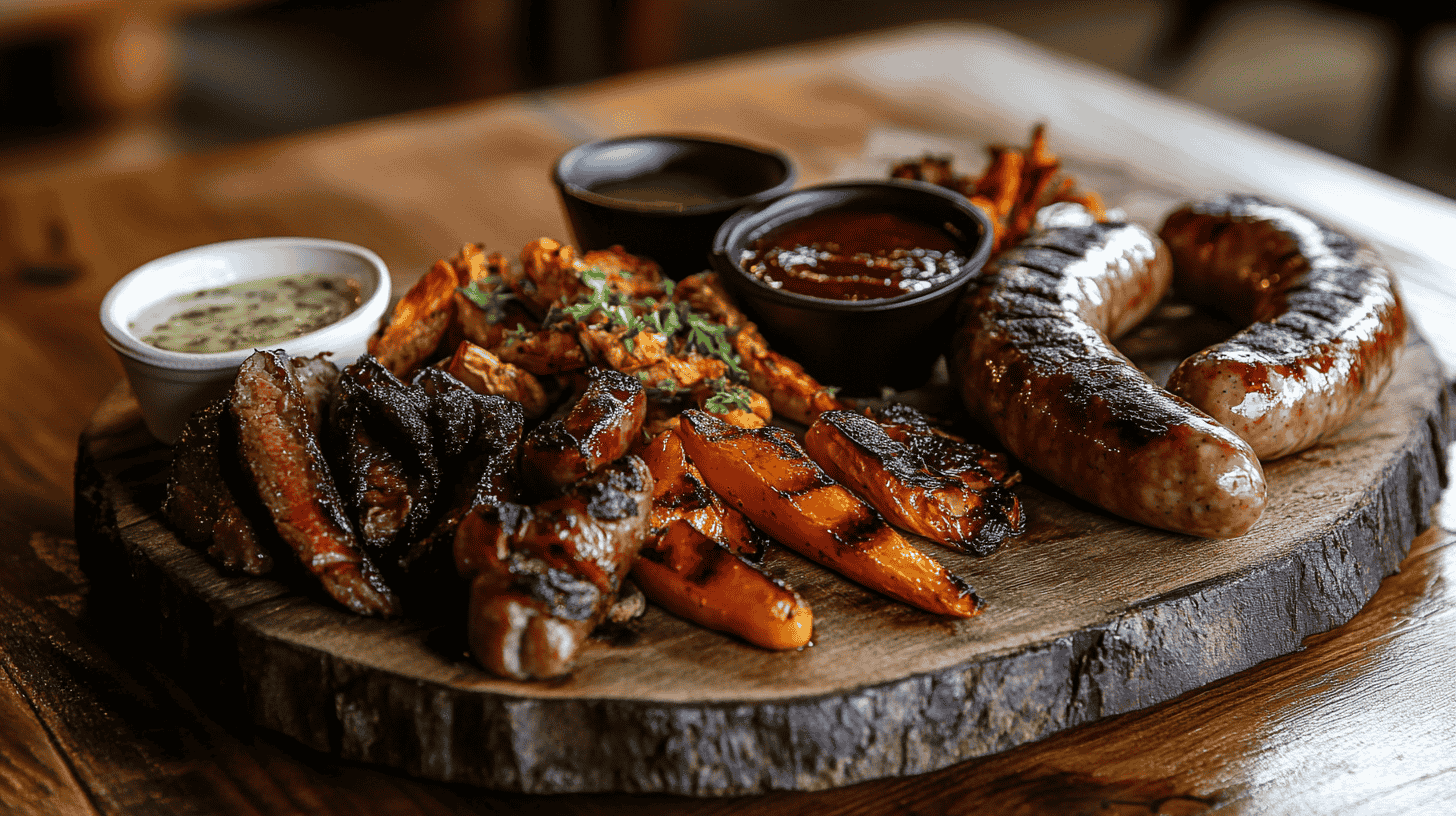Introduction to Beef Sausage

Beef sausage, a staple in many cuisines worldwide, offers a versatile and flavorful option for meals at any time of the day. From breakfast links to hearty dinner components, beef links comes in various forms, each with unique spices and preparation methods that cater to diverse tastes and dietary needs.
Understanding Beef Sausage
Definition and Varieties
What exactly is beef sausage? At its core, beef sausage consists of ground beef mixed with a blend of herbs and spices, encased in a skin that holds all the ingredients together. This simple and flexible definition covers many different products., from smoked varieties that are perfect for grilling to finely ground versions that are ideal for stovetop cooking.
Varieties of beef sausage can vary greatly depending on where you are in the world. In the United States, you might find beef kielbasa or beef bratwurst, which are popular at barbecues and picnics. Meanwhile, other regions might offer unique takes, such as the spicy beef chorizo found in Latin American cuisines or the beef boerewors, a type of sausage that is a favorite in South African culinary traditions.
Popularity and Cultural Significance
Beef sausage is popular not only for its delicious taste but also for its cultural significance in many culinary traditions. It features prominently in traditional dishes like Scottish haggis, where it blends with other meats, and Italian salsiccia, which pairs perfectly with pasta and stews.
Why do so many cultures love beef sausage? One reason is its ability to absorb flavors from herbs and spices, making it highly versatile for different recipes. Additionally, its firmer texture compared to other types holds up well during cooking and delivers a satisfying chew that enhances many dishes.
Composition of Beef Sausage
Understanding what goes into smoked meats is crucial for appreciating their unique flavors and textures. Let’s break down the typical ingredients and processing methods that define this beloved food item.
What is Beef Sausage Made Of?
This meat product primarily consists of ground beef, but its distinctive seasoning and additives are what truly differentiate it. Key ingredients often include salt, pepper, garlic, and a variety of spices such as paprika or fennel. Some recipes also incorporate fillers like breadcrumbs or grains to extend the meat or modify its texture.
Additionally, the fat content in beef links is important for flavor and juiciness. A higher fat percentage can lead to a richer taste and smoother texture, while leaner sausages are favored for their healthier profile but may require careful cooking to maintain moisture.
Types of Beef Sausage Around the World
As we explore international cuisines, this meat product adopts various styles, each reflecting the local flavors and culinary traditions. For example:
- In the United States, beef hot dogs and kielbasa are popular at sports events and family gatherings, known for their smoky flavor and firm texture.
- In Germany, you might encounter beef bratwurst, a sausage that is often seasoned with marjoram and served with sauerkraut.
- In the Middle East, beef sausages like sujuk are highly seasoned with garlic and red pepper, offering a spicy kick that complements a variety of dishes from breakfast to dinner.
These variations not only highlight the adaptability of beef sausage but also its role in bringing people together around the dining table, regardless of geography.
Nutritional Benefits and Downsides
When considering incorporating beef sausage into your diet, it’s important to understand its nutritional content and how it can impact your health.
Caloric and Nutrient Content
Beef links are a significant source of protein, essential for muscle repair and growth. A typical serving can provide a substantial portion of your daily protein requirements. In addition to protein, beef links are also rich in vital vitamins and minerals such as Vitamin B-12, crucial for brain health and maintaining energy levels, and zinc, which supports the immune system.
However, it’s important to note that beef sausages can be high in calories and fats, especially saturated fats. These can contribute to heart disease if consumed in excess. Additionally, many beef sausages contain sodium, which can raise blood pressure levels if consumed excessively.
Health Considerations
While beef sausage can fit into a balanced diet, there are some considerations to keep in mind:
- Moderation is key: Due to its fat and sodium content, it’s advisable to consume beef sausage in moderation. Pairing it with healthy sides such as vegetables or whole grains can balance out a meal.
- Cooking methods matter: How you prepare beef links can also affect its healthiness. Grilling or baking instead of frying can reduce the amount of added fats.
- Choose lower-fat options: Some manufacturers offer lower-fat versions of beef sausage, which can be a healthier choice for those looking to reduce their fat intake.
Rich in protein and essential nutrients, beef sausage is a valuable addition to meals. However, moderation is key due to its fat and sodium content. Curious about other premium beef options? Check out our Wagyu Beef Guide for more insights.
Cooking With Beef Sausage
Beef sausage is a culinary chameleon, able to transform into a wide range of dishes. Whether you’re preparing a quick breakfast, a hearty lunch, or a flavorful dinner, beef sausage can elevate the meal with its rich taste and satisfying texture.
Recipes Featuring Beef Sausage
- Breakfast Scramble
Start your day with a protein-packed beef sausage scramble. Slice the sausage into thin rounds and sauté it with diced onions and bell peppers. Add beaten eggs and stir until cooked through. Serve with whole-grain toast for a complete meal. - Beef Sausage Pasta
For a quick and comforting dinner, combine beef links with your favorite pasta. Cook the sausage until browned, then add marinara sauce, garlic, and a pinch of red pepper flakes. Toss the sauce with cooked pasta and sprinkle with Parmesan cheese. - Stuffed Bell Peppers
Hollow out bell peppers and fill them with a mix of cooked rice, diced beef sausage, tomatoes, and shredded cheese. Bake until the peppers are tender and the filling is golden. - Grilled Beef Sausage Skewers
Thread chunks of beef links onto skewers with cherry tomatoes, zucchini, and onions. Grill until the vegetables are tender and slightly charred. Serve with a side of garlic yogurt sauce for dipping.
Tips for Cooking Beef Sausage
Cooking beef sausage isn’t just about throwing it on the stove or grill—it’s an art that can enhance its flavor and texture. Here are some tips to get the most out of your beef links:

- Pre-cook for Even Browning: If using whole sausages, boil them briefly before grilling or pan-frying. This ensures the insides are fully cooked without burning the outer casing.
- Don’t Poke Holes in the Casing: The casing locks in the juices. Poking holes may cause the sausage to dry out and lose its flavor.
- Experiment with Spices: If you’re using plain beef links, consider enhancing them with your own seasonings during cooking. Ingredients like paprika, garlic powder, and dried thyme cancomplement the meat’s natural richness.
- Pair with Fresh Ingredients: Serve beef sausage with fresh salads, roasted vegetables, or whole-grain sides to create a balanced and satisfying meal.
Enhancing Flavors with Simple Additions
Adding complementary ingredients can transform a simple beef sausage dish into something extraordinary. For example:
- Caramelized onions: Add sweetness and depth to your sausage dishes.
- Fresh herbs: Sprinkle chopped parsley, cilantro, or basil for a pop of freshness.
- Sauces: Serve with mustard, barbecue sauce, or a tangy tomato relish for added flavor.
Cooking with beef sausage is all about creativity. With a few simple techniques and fresh ingredients, you can create meals that are not only delicious but also memorable.
Beef Sausage vs. Other Sausages
Beef sausage stands out in the crowded world of sausages for several reasons, from its flavor profile to its nutritional benefits. But how does it compare to other types of sausages made from pork, chicken, or plant-based ingredients? Let’s dive into the differences.

Comparing Flavors and Textures
- Beef Sausage
Beef sausage has a robust, hearty flavor that is often described as richer and more intense compared to other sausages. Its texture is generally firmer, which makes it a favorite for grilling and roasting. - Pork Sausage
Pork sausage tends to have a milder, slightly sweeter taste. It often contains more fat than beef links, which makes it juicier but also higher in calories. - Chicken Sausage
Chicken sausage is known for its light flavor and lower fat content. While it’s a good option for those seeking a leaner alternative, it may lack the bold taste and satisfying bite of beef sausage. - Plant-Based Sausage
Plant-based sausages have come a long way in mimicking the taste and texture of meat. While they are often healthier in terms of fat and calorie content, they may not fully replicate the rich flavor of a beef sausage.
Nutritional Comparisons
| Type | Calories per 100g | Protein (g) | Fat (g) | Notable Features |
|---|---|---|---|---|
| Beef Sausage | ~250 | 14 | 20 | Rich in protein and iron |
| Pork Sausage | ~300 | 12 | 25 | Higher fat content, milder flavor |
| Chicken Sausage | ~150 | 15 | 8 | Leaner option, lighter taste |
| Plant-Based Sausage | ~180 | 10 | 10 | Lower fat, high in fiber |
Beef sausage strikes a balance between flavor and nutrition, offering a high protein content and essential nutrients like iron and B vitamins. However, its fat content is worth noting for those watching their calorie intake.
Why Choose Beef Sausage?
Beef sausage has several qualities that make it a preferred choice for many:
- Flavor Depth: Its rich taste pairs well with bold spices, making it a star ingredient in recipes that require strong flavors.
- Versatility: From grilling and pan-frying to stewing, beef links adapt well to various cooking methods.
- Nutritional Value: Compared to pork sausages, beef sausage often contains slightly less fat while still providing essential nutrients.
Cultural and Regional Preferences
The choice of sausage often depends on regional tastes and culinary traditions. For instance:
- In the Mediterranean, pork sausages dominate due to the prevalence of pigs in the region.
- In the Middle East, beef sausages are preferred for cultural and dietary reasons.
- In health-conscious communities, chicken and plant-based sausages are gaining popularity as alternatives.
While all sausages have their merits, beef sausage holds its own as a flavorful, protein-rich, and versatile option that appeals to a wide audience.
Frequently Asked Questions
Beef sausage is a popular ingredient, but it often sparks questions about its composition, preparation, and uses. Below, we answer some of the most frequently asked questions to clarify any doubts and enhance your understanding.
What is Beef Sausage Casing Made Of?
beef links casing can be made from different materials, depending on the type of sausage. Here are the most common types:
- Natural Casings: These are made from cleaned and processed animal intestines, often from cows or sheep. They provide a traditional, firm texture and are considered the best for grilling and frying.
Example: Many artisanal sausages use natural casings to achieve an authentic taste and texture. - Collagen Casings: Derived from beef or pork hides, these casings are uniform in size and easier to work with than natural casings. They’re often used in mass-produced sausages.
Tip: Collagen casings are ideal for making sausages at home due to their consistency. - Synthetic Casings: These are made from materials like cellulose or plastic and are typically removed before consumption. They’re commonly used for processed sausages like hot dogs.
If you’re looking for sausages without animal-derived casings, there are also plant-based alternatives made from seaweed or other vegetable fibers.
Is Jimmy Dean Sausage Beef?
Jimmy Dean sausages primarily use pork, but the brand also offers beef sausage options. These beef products uphold the brand’s reputation for high-quality standards and flavorful seasoning.
- If you’re searching specifically for beef sausage, check the product label carefully, as most Jimmy Dean products default to pork.
What Exactly is Beef Sausage?
Beef sausage primarily consists of ground beef mixed with a variety of seasonings and spices. It is encased in natural, collagen-based, or synthetic casings and is cooked, smoked, or cured based on the desired final product.
What makes beef sausage unique is its hearty flavor, which serves as a versatile base for countless recipes. From breakfast dishes to dinner entrees, beef links fits seamlessly into almost any meal.
How Do You Store Beef Sausage?
Proper storage is crucial to maintaining the flavor and safety of beef sausage. Follow these guidelines:
- Refrigerate Fresh Sausage: Keep fresh beef sausage in the refrigerator and consume it within 1–2 days.
- Freeze for Longevity: If you need to store it longer, freeze the sausage. Wrap it tightly in plastic wrap or aluminum foil and place it in a freezer-safe bag.
- Cooked Link: Store cooked beef sausage in an airtight container in the fridge for up to 4 days.
How Can I Tell if Beef Sausage is Fully Cooked?
A fully cooked beef sausage should have a firm texture and an internal temperature of at least 160°F (71°C). Use a meat thermometer for accuracy, especially when grilling or baking sausages.
Wrapping Up
Key Takeaways
Beef sausage remains a beloved ingredient across the globe, valued for its rich flavor, nutritional benefits, and versatility in the kitchen. Here are some key points to remember:
- Unique Flavor: Beef sausage offers a hearty and robust taste that stands out compared to other types of sausage.
- Versatile Ingredient: From breakfast scrambles to hearty pasta dishes, beef sausage can complement a wide variety of meals.
- Nutritional Value: While high in protein and essential nutrients, beef sausage should be consumed in moderation due to its fat and sodium content.
- Cultural Significance: This sausage type has a prominent place in many cuisines, from Middle Eastern sujuk to American barbecue favorites.
Whether you’re grilling for a summer cookout or adding protein to a weeknight dinner, beef sausage provides endless possibilities for delicious, satisfying meals.
Future Trends in Beef Sausage Consumption
The food industry continues to evolve, and beef sausage is no exception. Here are some emerging trends that are likely to shape its future:
- Healthier Alternatives: Manufacturers are exploring ways to create lower-fat, reduced-sodium beef sausages without sacrificing flavor. These options cater to health-conscious consumers who still want the rich taste of beef sausage.
- Artisanal and Local Products: As people seek higher-quality ingredients, there’s a growing demand for locally sourced, small-batch beef sausages made with unique spice blends and natural casings.
- Sustainable Practices: With sustainability becoming a key focus, some producers are turning to regenerative farming practices and eco-friendly packaging for their beef sausage products.
- Exploring Bold Tastes: Anticipate the introduction of striking and distinctive flavors, like beef links combined with unusual spices, herbs, or even plant-based elements for mixed products.
These trends indicate that beef sausage will continue to adapt to modern tastes and lifestyles while maintaining its place as a culinary favorite.


